



ACP CP Statement o of Ne Need (on b behalf o of the B BGA) A)
Gl Gliding 22 UK gliding world champions since 1952, the most recent in 2017 While “joyriding” and local soaring are facets, a major aspect of club’s work is to develop current and new pilots to emulate or better these performances Their goal is to fly cross-country Experienced pilots achieve flights covering hundreds of kilometres and lasting several hours. ‘Out and return’ flights in excess of 500 km (occasionally 750 km) are regularly achieved from local clubs Two cross-country competitions of national importance are run in the area
Gl Gliding The principles of gliding are simple The pilot is flying an aircraft that is constantly descending and utilises rising air, whether from thermals, ridges or lee-wave, to remain airborne. A glider is around 10 minutes away from a potential landing unless the pilot can find rising air to climb and remain airborne. The concentration required to utilise rising air and, at the same time, maintain constant look out at the surrounding sky for other aircraft cannot be underestimated. Gliding is a technically demanding, environmentally friendly, mentally challenging air sport Gliding is also recognised as a pathway to careers in the UK aviation and aerospace sectors and is a significant part of GA’s overall economic contribution to the UK.
Impact o of Cl Class D D Airspace o on Gl Gliding and powered G GA Aircraft intending to enter CAS have to make a request at • least 10 minutes before entry (in accordance with UKAIP 1.6.5.) For aircraft flying at 90 kts this equates to 15nm and for 120 kts to 20nm. As an example, over an area stretching from Huddersfield in • the West to Grimsby in the East and from York in the North to the East Midlands CTR in the South, (10,265 sq km) pilots wishing to cross DSA CAS have to be in contact with DSA ATC, filing flight plans and obtaining clearance. Pilots should be “aviating and navigating” rather than • “communicating” the administrative arrangements needed to enter an area which has a traffic density much lower than the surrounding area.
Impact o of Cl Class D D Airspace o on Gl Gliding Due to airspace restrictions to the North, the Pennines • to the West sand the sea to the East cross-country flights from northern clubs are usually tasked to the South Gliders are rarely able to enter Class D due to the • increased workload of communicating plus the difficulties of maintaining a level or following a clearance accurately All gliders flying cross-country tasks are radio-equipped • and an increasing number are being fitted with Mode S transponders When clearances are requested refusals occur even to • transponder equipped gliders
Impact of Class D D on G Gliding g Between DSA and LBIA CAS traffic is • forced into a narrow corridor (the Upton Corridor) increasing the probability of conflicts East of DSA CAS gliders (and GA and • military traffic) are forced into a Glider cross-country routings prior to the introduction of DSA CAS narrow corridor (Trent Valley), between the CAS, the permanent D313 Red Arrows practice area and the Lincolnshire MATZ cluster considerably increasing the probability of conflicts These choke points make it much • more difficult to fly North/South, South/North transits and destroy a nationally important cross-country soaring route. Glider cross-country routings post the introduction of DSA CAS
Impact of Class D D on G Gliding g New ACPs (to address • implementation of new PBN/RNAV1 SIDS/IAPs/STARs) are being submitted by DSA, LBIA and DTVA The DSA proposal adds extra Class D • to the East effectively putting a lid on the “Trent Valley” funnel, an area where gliders need height to cross a wet area not conducive to thermal production and affected by the sea breeze The LBIA proposal lengthens and • narrows the Upton Corridor making glider transits via this route almost impossible Historic clubs will face losing up • 50% of their business
Airpor ort Gr Growth Fore recast sts • All airports used increasing PAX and ATM as justification for their initial airspace requirements • While none have met those targets or are on a trajectory to meet them they still use those predictions to justify their airspace and indeed additions to it • Future forecasts take no account of “fragile” financial situation of more than one key operator or the potential (now actual) reduction of eastern European migrant traffic, post Brexit • No reason to believe future forecasts anymore robust than those used to justify original ACP
What at w we’ve g got • Large areas of under utilised Class D that’s virtually unusable because of the increased workload and refusal of access • ACP sponsors that don’t consult with our community • ACP sponsors that assume they’re going to get the airspace they ask for • ACP sponsors that do not consider the impact of their changes outside their airspace • ACP sponsors that misrepresent and ignore our responses to consultation • ACP sponsors that know nothing about gliding • No apparent process for de- classifying under utilised Class D • Airports that never give a clearance • Airports that can’t give clearances “because we’re closed”
What w we e need eed • a solution proportionate to need • providing the flexibility of access, transit and movement required by all users • improving safety for all • but also: • recognising the need for NPRs, acceptable to local residents • compatible with the existing airways • ensuring CAT benefit from operating in a known air traffic environment
Option ons Discuss please!
Recommend
More recommend